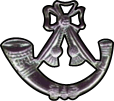|
Battle of the Longwoods - Battle Hill
Following the defeat of Proctor and Tecumseh
at the Battle of the Thames in October of 1813, the southern peninsula
was virtually left abandoned by both the British and the Americans. The Americans
used this area to gather supplies i.e. grain, cattle and ground flour to help feed their garrisons at Detroit and the smaller group at Amherstburg. Foraging parties from both sides frequented the area in search of the ever diminishing
foodstuffs and perhaps, if fortunate an occasional enemy party.
After the Thames
Battle, the British has in a moment of panic, withdrawn to Burford, but upon realization that the Americans under Harrison
had withdrawn, moved forward and established outposts at Oxford, Turkey Point, Port Talbot, Putnam’s and by January
of 1814 a larger one at Westbrook’s Farm just outside the small town of Delaware on the Commissioners Road. During this time a considerable force of men were assembled under the command of Captain Alexander Stewart
of the Royal Scots Regiment. He was officially the Lieutenant Colonel of the
London District. At Delaware, he not only had about 120 men of the Royal Scots
but also 50 of the light company of the 89th regiment whose officer was Captain James Basden, second in command
to Stewart, about 50 McGregor’s Kent Volunteers, in addition to which there were 40 – 60 Caldwell Rangers under
William Caldwell and his half brother Billie Caldwell.
On March 3, 1814 an advance party of Caldwell’s Rangers spotted a large group
of American soldiers along the Longwoods Road, on their way to attack Delaware about six miles east of Fourteen Mile Creek. (This is the ravine nearest the former community of Strathburn). William Caldwell and his men made a brief but feeble attack at the enemy who were on the west side of a
very steep ravine known as Twenty Mile Creek. Caldwell determined that he was outnumbered, hurriedly withdrew towards Delaware on the morning of the 4th of March. He reached Fourteen Mile
Creek and set up an encampment there, waiting for reinforcements and orders from Delaware where he had sent his messengers on the evening of the 3rd.
Meanwhile, the Americans
under Captain A H Holmes of the 24th regiment, established a breastwork in the form of a square on the top of western
ridge of the ravine. Logs were laid on the ground and brush was thrown up to
afford his men some cover from the expected attack. However, when the British
withdrew after their brief encounter he sent an officer to investigate. Lieutenant
Knox reconnoitered the British camp on the east side of the ravine and found them to have fled, leaving their baggage along
the roadside. They had only amounted to about 70 men. Upon hearing this report, Holmes’ men mounted their horses and headed eastward in hot pursuit of
the ‘fleeing’ enemy.
As was the custom,
Holmes sent out an advance under a Captain Lee. After travelling only about four
miles Lee reported that the enemy was one mile ahead, preparing for battle and in considerably larger numbers than they were
expecting. In his description of the Battle,
Holmes claimed the British had attempted to induce him from his secure encampment and outflank him. From British reports however there appears to have been no such elaborate plan as Caldwell’s small force was clearly out numbered by the Americans. What
Lee took as the British preparing for battle was probably Caldwell’s men
digging in.
 |
 |
|
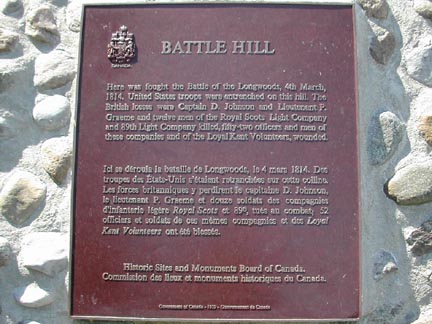
|
|
BATTLE HILL
Here was fought the Battle
of the Longwoods, 4th March,
1814. United States troops were entrenched
on this hill. The
British losses were Captain
D. Johnson and Lieutenant P.
Graeme and twelve men of
the Royal Scots Light Company
and 89th Light Company killed, fifty-two
officers and men of
these companies and of the Loyal Kent Volunteers,
wounded.
Historic Sites and Monuments Board of Canada.
|
|
 |
 |
Captain Stewart,
although in command and apparently having every intention of leading the party to intercept the enemy force then thought to
number only 50 or so men, was tied up in a meeting with Colonel Matthew Elliott who was leading a group of Indians that Stewart
wanted to go with the intercepting party. However the Indians had been exhausted
and were unwilling to leave at that moment so Stewart wished to discuss when they would be going. As a result, he sent his second in command Captain James Basden on to join Caldwell’s Party. Basden’s report on the battle implies that his orders were to move forward and
support Caldwell and to push on as far as Ward’s.
(Site of Wardsville). Stewart denied this and implied he fully expected
Basden to join with Caldwell and wait until he (Stewart) arrived, before beginning the battle. Times have not changed in the last 190 years as we find all those involved justifying
their own position regardless of the outcome.
Holmes, having discovered
the possibility that his men may be trapped and encircled by a numerically superior force of British, rapidly retreated to
his encampment at Twenty Mile Creek where he and his men vowed to fight to the death.
Basden decided to
rest his men at Fourteen Mile Creek and wait for the arrival of the Indians. Only
five of them showed. He left a Mr. Fraser of the Indian Department behind to
hurry any more Indians along if they came. He and his group of Royal Scots, 89th,
Rangers and Volunteers and five Indians struck out along the Longwoods Road towards Ward’s Inn. The day was quickly passing
and Basden was impatient to get on with the task at hand as he saw it. As they
approached Twenty Mile Creek they could smell the smoke of the campfires and hear the voices of the Americans. He decided to attack immediately before nightfall. Just as
he was mustering his men for the attack, Fraser came up with 23 more Indians. Basden’s
plan was to send the militia around to the left of the Americans where they would come from the rear of the encampment. They would withhold their fire until they were in position and then signal Basden
and his regulars with a bugle call. History records that the Militia officers,
Caldwell and McGregor tried to persuade Basden to also flank the Americans but Basden favoured a direct frontal assault with
the 28 Indians forming his right flank.
The Americans formed
a hollow square with the eastside defended by men of the 24th and 28th regiments. The eastside of the square had no breastwork but was protected by the steep sided ravine and the wooded
slope. The south side was defended by the Militia, while Rangers manned the west
wall and Garrison troops from Detroit were stationed on the north side which ran parallel to the road.
Basden reported that
he saw a brushwood fence but assumed it to be a simple road block. Time was of
the essence to this young officer and it appears he felt simple British dash and vinegar was all that was needed to carry
the day. It was approximately 5:00 p.m. and
light would be quickly be diminishing. Action was what was needed. The sound of the bugle shattered the winter silence as both sides prepared for battle.
From Holmes’
perspective he heard bugles sounding from the north, the south and the west side of him.
His men must have crouched a little lower below the brushwood fence. With
the bugles the British regulars charged in open column down the steep eastern slope of the ravine towards the narrow wooden
makeshift bridge that spanned the creek at the bottom of the ravine. As they
surged forward, the Americans on the eastside of square poured down a what Holmes described as a most destructive fire. The courageous British regulars of the Royals and the 89th were “shot
to pieces” even before they reached the bridge.
At the bridge, under
the withering fire from above the column, whose front ranks were decimated, momentarily halted but as a cheer was given they
raced across the bridge and began to struggle up the steep and slippery incline of the western cliff. All the time the murderous fire continued to bite away at then, slowly and cruelly thinning their numbers.
Legend has recorded
that the Americans had poured water from the creek down the slope to make it extra icy, The documents of the time mention
no such action. It wasn’t needed.
The troops were equipped with only leather shoes totally inadequate to achieve any sort of grip on the snowy, slippery
cover of the incline.
Basden apparently
saw that he and his troops were in a very precarious position since they had advanced to within 10 – 15 paces of the
edge of the ravine but due to their inadequate traction as well as the deadly fire could not reach and indeed could not rush
the enemy who continued to crouch below the edge of the hill when sporadic fire was returned by the British. Basden says had his men move along the ravine to the right (north) under “an uncommon fire”.
When he reached a
point where he thought his men could make a better rush for the top, he realized that he was not only facing a brushwood fence
but also an abattis of sharpened logs designed to prevent such a maneuver. Undaunted,
he ordered his men to take cover in extended order behind the trees and shoot it out with the enemy until he could think of
an alternative. Holmes described the trees that covered the bank as being thin
and unsuitable to hide one man let alone groups of scarlet and grey clad regulars. Despite
their awkward position, these very brave soldiers so foolishly led, shot it out with the unseen enemy who could duck behind
logs when being fired at. The fighting on the other sides of the hollow square
encampment was as Holmes described cool and leisurely since the Americans could shoot without exposing themselves. Patriotic versions of the battle written by Canadians seeking to glorify our ‘boys’ would have
people believe that the Rangers and Volunteers were almost a wall and very near taking the Americans. The true story appears far different. Almost every officer
of the regulars who were part of the frontal assault and the militia who were attacking form at least the two sides were either
wounded or killed. Lieutenant McGregor of the Kent Volunteers was shot in the
arm so severely that a few days later there was concern that his arm would be amputated.
Our historians expressed an opinion that an American soldier armed with a rifle could hit his target 6 or 10 tries
on the average, while a British or militiaman armed was the Tower smooth bore musket, standard issue to the British arm for
over 150 years, could manage only 3 of 10. On March
4, 1814 this was the story. The ranks of the British
and Canadians were so scattered and thinned they could bring no volume of fire to bear on their hidden foe.
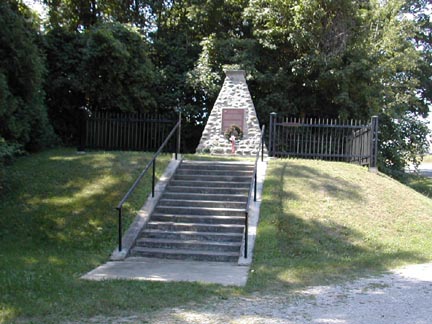
Meanwhile, mercifully, dusk was approaching Basden said in his chronicle of the affair that he
was intending to seek more reinforcements by sending runners back to Delaware and then was planning to storm the enemy. Fortunately for the survivors, as Basden clung behind a tree, a shot hit him in the
thigh totally obliterating his alternative plan. It was dark now and as he was
being carried back down the ravine a general and orderly withdrawal took place. Captain
Stewart arrived in time to see the tattered remnants of his army clamber up the slope of the eastside of the ravine. He gave the order to retreat. The only
unwounded officer left among the regular officers was Ensign Mills who, for a very brief moment, found himself in command
of a scattered and decimated army.
Stewart led the remaining
troops along with the wounded that could be retrieved, back to Fourteen Mile Creek, where he prepared his dispatches, to tell
his superiors of the ‘most unfortunate affair’. The wounded were
taken to Delaware and the next day carried to Oxford, the nearest Hospital. Much to the surprise of the British, the Americans withdrew at 8:00 p.m. the same night, leaving the dead and the wounded on the battlefield.
Holmes made no bones
about why he retreated after such a one sided victory. He had three reasons. Firstly, for all he knew, reinforcements for the British could be on their way and
he knew he would be outnumbered. It would be foolish to chance his success. The second reason was that if he left his position to advance or remained where he
was, he could be outflanked. The third reason was on of practicalities. His men had walked over 60 miles through woods, swamps and rivers in less than a week
in very cold weather. Some of his men had only stocking feet as their shoe leather
literally, fell apart. His men were simply exhausted.
The Americans suffered
a total of seven casualties, a non commissioned officer and six privates wounded. British
losses were disastrous. In the Royal Scots Light company, one Sergeant and nine
rank and file were killed while one Lieutenant, one sergeant and thirty one privates were wounded. In the 89th Light Company one Lieutenant and three rank and file were killed. One Captain (Basden) one sergeant and seven rank and file were wounded.
The Loyal Kent Volunteers had a Lieutenant and five rank and file wounded while the Rangers appeared to have escaped
unscathed. The actual fight lasted over one hour.
Holmes called it a close and gallant conflict praising the courage of the British regulars whom, he said were shot
to pieces. He thought that Basden had been killed early in the conflict. He said that he would not allow his men to remove any articles of clothing from the
dead or wounded even his soldiers who had no boots left had to leave in stocking feet.
With him went two prisoners only, a bugler from the Royal Scots and Volunteer Piggott of the 89th. As he left the battlefield that night he had the impression that there were 80 to
90 dead or wounded. No attempt was made to bury the bodies by either side. Five or six of the British wounded died within the next few days after the battle.
{Clarification, the
Western Rangers or Caldwell Rangers were headed up by Lieutenant Colonel William Caldwell, senior. At the Battle of the Longwoods, the Rangers were under the command of Captain William
Caldwell, junior, Billie Caldwell lead
the Indian component of the Rangers.}
Each year on the
first weekend in May the Upper Thames Military Reenactment Society with members of other Canadian and American re-enactment
groups relive the Battle of Longwoods.
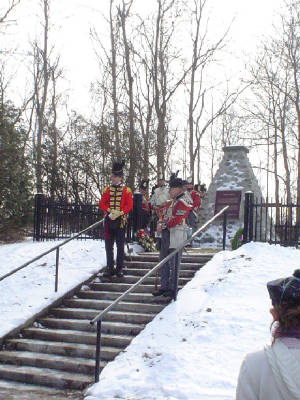
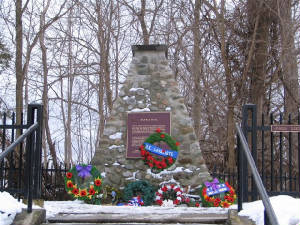
|
